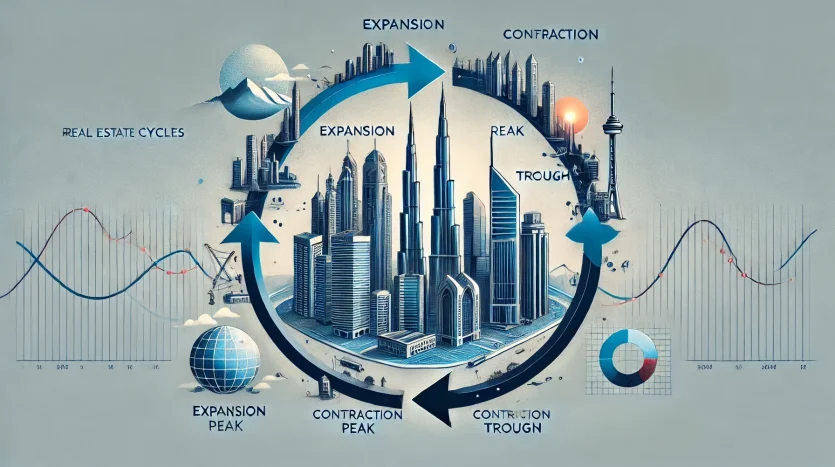Understanding Real Estate Cycles: Key to Successful Investment Strategies
n the ever-evolving world of real estate investing, understanding the cyclical nature of the market is crucial for making informed decisions. Whether you are a seasoned investor or just getting started, recognizing the phases of the real estate cycle can help you maximize returns and minimize risk. In this post, we’ll dive deep into the four phases of real estate cycles, using examples from Dubai, Luxembourg, and Vancouver to illustrate the real-world impact of these cycles on property prices and investment opportunities.
Keyphrase: Real Estate Cycles and Investment Strategies
The Four Phases of Real Estate Cycles
Real estate cycles typically follow a recurring four-phase pattern: expansion, peak, contraction, and trough. Each phase brings distinct characteristics that affect property prices, supply and demand dynamics, and investor behavior.
1. Expansion Phase
The expansion phase is marked by strong growth in the real estate market. During this time, low interest rates, population growth, and investor confidence drive up demand for properties. Developers respond by increasing construction activity, trying to meet the heightened demand.
Example: Dubai’s Boom Dubai experienced a major expansion in its real estate market during the early 2000s. Its strategic location as a hub between East and West, combined with a booming economy, attracted businesses, investors, and tourists alike. Iconic landmarks like the Burj Khalifa and Palm Jumeirah were built during this time, and property prices surged as investors from all over the world sought to capitalize on the city’s meteoric rise.
2. Peak Phase
The peak phase occurs when the real estate market reaches its highest point. Property prices are at their peak, demand remains strong, but signs of an overheating market start to appear. Investors often become speculative, driving prices to unsustainable levels.
Example: Luxembourg’s Real Estate Surge Luxembourg is currently in the peak phase of its real estate cycle. Fueled by economic growth and foreign investment, property prices have soared, particularly in prime areas like Luxembourg City. While this boom has brought prosperity, concerns about affordability and sustainability are growing as prices continue to rise.
3. Contraction Phase
In the contraction phase, the market begins to cool off. Property prices start to decline, demand weakens, and speculative behavior decreases. The contraction phase can be a period of uncertainty, as investors become more cautious and fewer transactions take place.
Example: Vancouver’s Overheating Market Vancouver saw rapid property price appreciation in recent years, driven by foreign investment and a limited supply of housing. However, as affordability became a concern, speculative buying slowed, and the market entered a contraction. Government interventions like foreign buyer taxes helped temper the market, leading to more stability.
4. Trough Phase
The trough phase marks the lowest point of the real estate cycle. Property prices stabilize, and economic conditions begin to improve. Investor confidence slowly returns, and the market begins its recovery, leading to the next expansion phase.
Example: New York City’s 19th Century Trough In the late 19th century, New York City experienced a downturn after years of rapid growth during the industrial boom. Property values declined, and vacancies increased. However, the construction of landmarks like the Brooklyn Bridge and the Statue of Liberty eventually revitalized the city, leading to a recovery in the real estate market.
Strategies for Navigating Real Estate Cycles
Understanding the phases of the real estate cycle is critical for developing sound investment strategies. Here are some tips for navigating each phase:
- Focus on Fundamentals: Instead of chasing short-term market trends, focus on long-term fundamentals such as location, market demand, and property potential.
- Diversify Your Portfolio: Spread your investments across different property types and locations to mitigate risk and protect against market downturns.
- Avoid Speculative Buying: Resist the temptation to follow herd behavior or speculate based on short-term price spikes. Stick to your investment strategy and make decisions based on thorough research.
- Seek Professional Guidance: Work with experienced real estate agents, brokers, or financial advisors who can offer insights and help you make informed decisions.
Conclusion
Real estate cycles are an integral part of the property market, shaping cities and investment opportunities in ways both predictable and unexpected. By understanding the expansion, peak, contraction, and trough phases, investors can make smarter, more informed decisions. Whether you’re eyeing a booming market like Dubai or analyzing the affordability challenges in Vancouver, keeping a long-term perspective will help you navigate the complexities of real estate investing.
Stay tuned to Real Estate Beat for more expert insights and tips on navigating the dynamic world of real estate. Happy investing!




